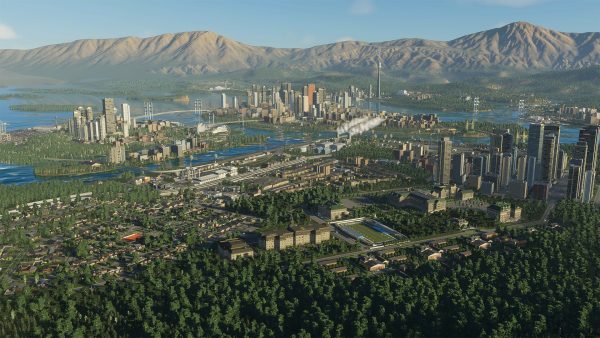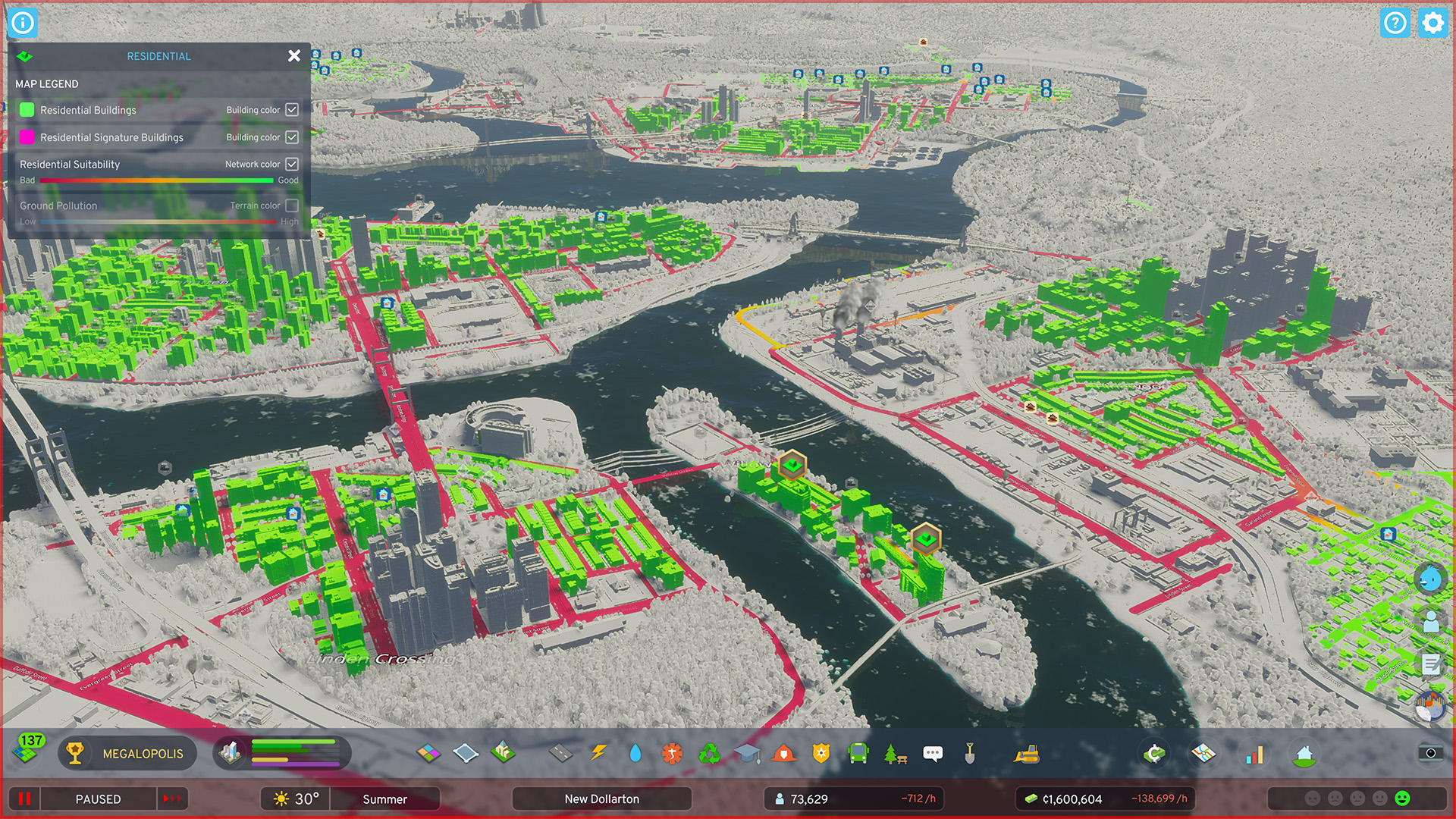For Claire Basinski, like many other millennials, the original SimCity served as her closest exposure to city planning in her youth. Today she’s president of the Ontario Professional Planners Institute (OPPI), and she provided her reflections on the endless possibilities of the most recent city-building game to be released, Cities: Skylines II.
“This is maybe a full circle moment [for me] because I am one of those millennial children who grew up with the original SimCity, which was probably the precursor [to modern city building games], and definitely looks to be the case to this unbelievable tool,” she said.
Paradox Interactive’s Cities: Skylines II was released after grand anticipation to PC audiences on Oct. 24, while console owners will sit patiently till spring of 2024 after a delay was announced by the Swedish studio in late September. The game is the sequel to 2015’s hit Cities: Skylines, which went on to sell 12 million copies.
Basinski sees the game as an opportunity for an uber-realistic city building simulation to come to the forefront of public thought – something not seen even in the early golden years of the city-building genre with titles such as Don Daglow’s Utopia, which made a pixelated takeover of living room Intellivisions worldwide across the 1980s.
“The degree of complexity that this game accurately depicts is something I don’t think we have ever seen. It’s a combination of the progression of technology that we’ve been seeing in the planning world and other spaces, whether it’s AI or transportation traffic modelling. It just seems like it’s really one of the first tools that brings together the multitude of different facets and considerations when it comes to city building,” Basinski said.
Cities: Skylines II begins with a choice between 10 different maps to build your city on; these varied lands have different sets of unique factors one must decide on before embarking on the city-building, including varied climates, latitudes, buildable space, and natural resources available.
From there, similar to its predecessor, begins the affair of zoning of residential, commercial, and industrial areas, which will be familiar to veteran city-building aficionados. But the sequel begins showing its bite is in its new features, such as scalable and upgradable service buildings to match your city’s progress, and managing a well-run sewage and garbage system to avoid pollution and maintain a healthy water supply. A reworked progression system is also included featuring milestones that a player can choose to upkeep, like population growth, citizen happiness, and economic health.
From its launch, Cities: Skyline II ran into a set of early complications. Performance issues including general bugs and the game’s inability to run even on rather beefy PC setups left a sour taste in many fans’ mouths. Paradox Interactive has made available a set of patches meant to fix the issues that made the game unplayable for some.
Yet, the game’s merits far outweigh its technical errors. An important and crucial aspect for city planners is a need to improve the lives of those around them, something that Basinski sees value in, as it’s a way of thinking that hits close to her own origins within the profession.
Raised in the neighbourhood of Moore Park, one of Toronto’s most affluent neighbourhoods, she like many others was drawn to city planning as a way to rectify the inequality that creates comfort for some and discomfort for others based on something as minuscule as which postal code they call home.
“I saw the significant divides that our built forms, our built structures — the haves and the have nots — and the significant range and experience from a life perspective that people have just by way of how our cities are built and how our cities function,” she said. “I happened to write my incoming essay to the University of Waterloo on the juxtaposition of Rosedale and Regent Park. That’s where my passion started. It’s really the complexity that is city planning that sometimes gets oversimplified,” Basinski said.
Keeping the human pulse within the sometimes grandeur appeal of city planning is something the game begins to introduce to the conversation,
A boost is given to civilian simulation with AI systems tailor-made to reflect the human experience. Citizens are born into your city and go through the stages of life. They can be monitored going through their daily lives, attending work, school, getting married, and even going off to retirement as they age — their thoughts can be kept up through the game’s social media standing Chirper, adding a deeper slice of immersion, but also heart.
Basinski, who often works in infrastructure and servicing planning in the space of transportation, was also specifically impressed by the in-depth factors that were applied in order to accurately represent some of the processes she sees day-to-day.
“So I come at this from the perspective that I do a lot of work in infrastructure and transportation planning and I happened to see an example where they are bringing in traffic data, they’re also thinking about how time and comfort have an influence on human behaviour,” she said.
What she mentions is a feature called pathfinding, where the game uses built-in traffic AI that factors a city’s road network, comfortable distance and time of travel for citizens, cost of transportation, and even quality of roads and congestion of cars if one decides to nudge forward a large car-depended system rather than a model of public transportation.
“The one thing that does stand out is they refer to transportation as pathways, movement pathways and I think that is a really interesting and exciting way to start to rethink how transportation is planned and how people use it,” she said. “The reality is, when we step outside the spaces where we live, we are already transporting, we are moving somewhere, what we strive towards is to try to find the ways to connect all of these different pieces. And I use ‘connect’ intentionally because of course transportation and movement and pathways are sort of the cornerstone of that.”
A deeper focus on economics is another big addition. Players will have to manage their economy by balancing the supply and demand of production, adjusting private and corporate taxes, as well as goods and services. This money can then be invested in a variety of urban developments to further improve the city.
Yet, just as quickly, if economics and general population satisfaction are not kept up, citizens can fall ill, lose their jobs, face homelessness, or in moments of desperation even turn to crime.
“We don’t always get to see [the effects] in real-time at faster speeds so it would actually help to start to demonstrate more of the connections between what we call planning interventions or planning solutions, and the wider societal health impacts,” she said. “This is all about how humans experience place, and space and are able to live their lives in healthy sustainable ways that create resilient individuals and resilient communities.”
In Cities: Skylines II, players must consider issues such as budgeting, unexpected developments, bad investments, or even poorly constructed pipe systems to be crucial to the health of their creation, but similar to real-life planners they must be willing to adjust to the happenings of circumstance.
“It really is a profession of trade-offs based on professional experience and expertise. I have the pleasure of speaking on behalf of almost 5,000 members across the province of Ontario, who are all practicing in a space where it is our duty to work in the public interest and to put forward plans, proposals, and recommendations and do work that is meant to try to achieve these big visions of growth, healthy and sustainable communities, climate resilience, and overall public health,” she said.
Whether in the hands of an experienced city planner, a fan filled with anticipation, or even the wandering eye of an individual acting upon a mild interest — Cities: Skylines II, with all its faults and sky-high ambitions, provides an exciting ode to city building.
Images from Cities: Skyline II press kit





